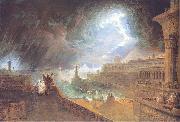Wholesale Oil Painting No Minimum |
|||||||||||
|
|
|||||||||||

|
|||||||||||
|
|
|
||||||||
John MartinBritish 1789-1854 John Martin Gallery His first exhibited subject picture, Sadak in Search of the Waters of Oblivion (now in the St. Louis Art Museum), was hung in the Ante-room of the Royal Academy in 1812, and sold for fifty guineas. It was followed by the Expulsion (1813), Paradise (1813), Clytie (1814), and Joshua Commanding the Sun to Stand Still upon Gibeon (1816). In 1821 appeared his Belshazzar's Feast, which excited much favorable and hostile comment, and was awarded a prize of £200 at the British Institution, where the Joshua had previously carried off a premium of £100. Then came the Destruction of Herculaneum (1822), the Creation (1824), the Eve of the Deluge (1841), and a series of other Biblical and imaginative subjects. The Plains of Heaven is thought to reflect his memories of the Allendale of his youth. Martin's large paintings were inspired by "contemporary dioramas or panoramas, popular entertainments in which large painted cloths were displayed, and animated by the skilful use of artificial light. Martin has often been claimed as a forerunner of the epic cinema, and there is no doubt that the pioneer director D. W. Griffith was aware of his work." In turn, the diorama makers borrowed Martin's work, to the point of plagiarism. A 2000-square-foot version of Belshazzar's Feast was mounted at a facility called the British Diorama in 1833; Martin tried, but failed, to shut down the display with a court order. Another diorama of the same picture was staged in New York City in 1835. These dioramas were tremendous successes with their audiences, but wounded Martin's reputation in the serious art world. |
||||||||
|
|
||||||||
The Seventh Plague
The Seventh Plague Painting ID:: 67011 |
Oil on canvas
144.1 x 214 cm
1823
Oil on canvas 144.1 x 214 cm 1823 |
|||||||
|
CONTACT US |

